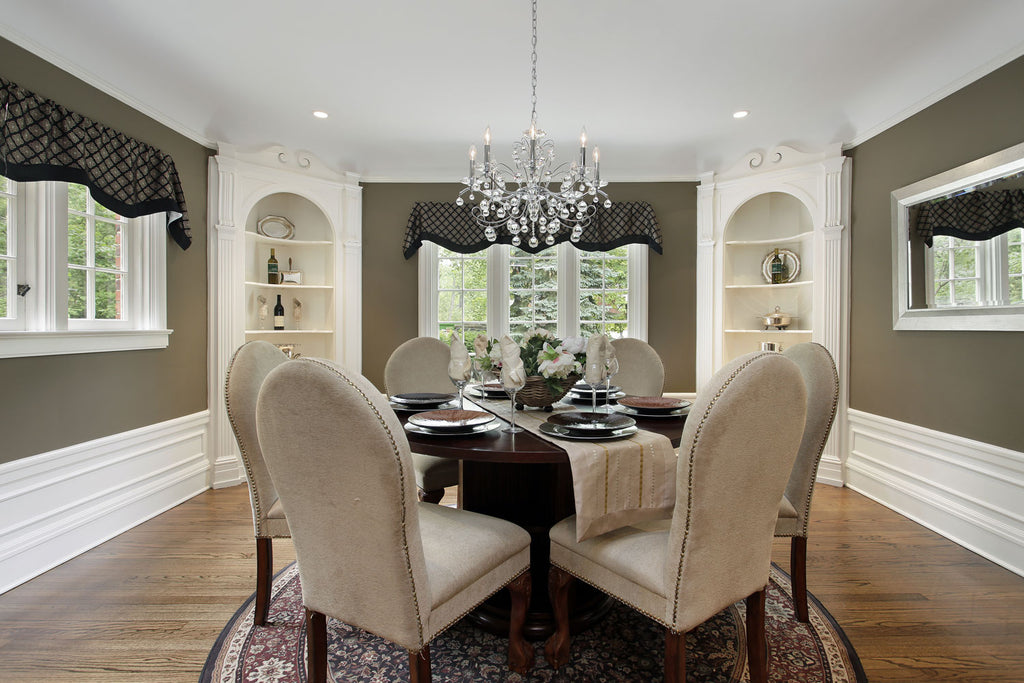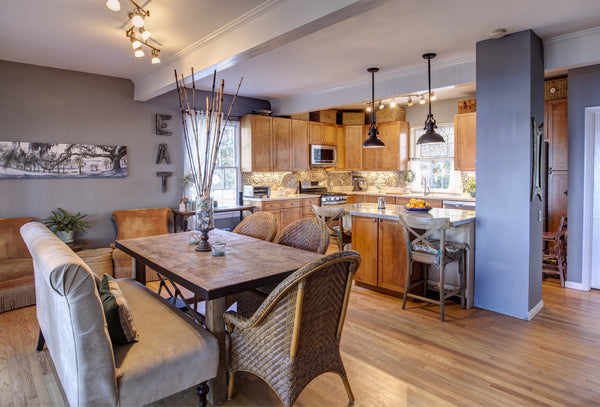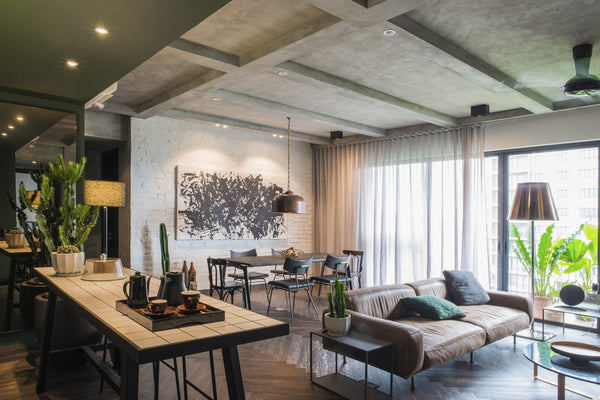On orders $99+
On orders $99+


From dinner with your family or drinking wine with guests, to doing work, your dining room is a versatile space. So, having the right lighting for your dining room to accompany each occasion is a must. A lot goes into creating the perfect lighting design. Lighting layers will impact the look and feel of the dining room so it is necessary to use the right fixtures to create such layers. Once you have your fixtures, placing them in their appropriate locations with the correct bulb is important for them work effectively. At the same time, these lights need to compliment the style of the dining room.
Finding the right lights can be a bit overwhelming if you don’t know the first thing about lighting design. And if you do know a little bit about lighting, thinking of ideas to enhance the space may be challenging. Luckily, here are 6 tips that will help you through the process.
Lighting creates the mood of a room. Ambience, accent, and task lighting are the foundation of lighting design that will produce your desired atmosphere. The key to your dining room lighting is to think about these layers for every square inch of the room. Ceiling, floors, walls, and everything in between. Fully illuminate your dining room, make it functional, enhance visual appeal, or add comfort. Choosing the correct layers will help you achieve your lighting purposes.
Ambience is the general lighting of a room that provides adequate illumination for you to safely move around the space. A decorative chandelier or pendants can be used as ambient lighting for your entire room, while adding visual intrigue and depth. Combine the sophistication of a geometric-shaped chandelier with the warm and welcoming feel of two wall sconces for an elegant restaurant-like atmosphere. Placing those sconces above a credenza or dining room fireplace mantel adds a traditional vibe. Throw recessed lighting in the mix for a stunning effect. Give yourself the freedom to adjust the ambience from bright illumination to a soft candle-like glow by combining a chandelier with a dimmer. But be sure the fixture is dimmable before buying it.
Recessed lighting and track lighting can also provide general lighting. Highlight artwork with recessed lighting, supplementing the fixtures with table lamps next to seating areas and a candle is another great setup for ambience. Bounce light off the ceiling with torchiere lamps to wash the wall, curtains, and art piece to create a warm and inviting glow. Create the same effect with a soffit or valance lighting.

Highlight decorative pieces and wall art in your dining room for a stunning effect with recessed lighting fixtures. Supplement chandelier light with recessed downlights placed around it. These fixtures will provide accent lighting for your table and other objects in the space. Use wall sconces in place of recessed lighting if you prefer. Wall sconces is another way to highlight your walls and important features you want to draw attention to. Make sure the wall sconces compliment the style and finish of your chandelier.

An oversized floor lamp is great for accent lighting and adding character to the room. Spacious dining rooms are perfect for buffet lamps. Supplement a single ceiling fixture using two buffet lamps that are, at most, 40 inches tall with 75 watt bulbs to create this layer. For smaller dining rooms, place a table lamp, no taller than 32 inches, on a side table for a nice visual.
To perform activities, such as eating and doing homework, you need functional lighting. Give yourself enough light for engaging in tasks with task lighting. Wall sconces and recessed lights are perfect for providing this layer. If you want to add style, a vintage warehouse-lighting fixture is a good option. Ceiling hanging fixtures, such as a decorative chandelier, placed over your table is another good source of task lighting. Standing lamps and table lamps are popular options because they are movable, allowing you to light areas you plan to use. Control light with different types of shades to create a soft glow or bright illumination.
Be sure to measure your fixture and area properly before installing it. Pendants and chandeliers should be hung at the correct height, typically 36 inches above the surface of the table. For a larger dining room or higher ceilings, you will want 40 inches of space. So, when you’re looking for fixtures, consider the suspension length. But don’t feel bound to a certain height. Try different lengths and see which one looks best. Note that hanging a fixture too high will make it look like it’s stuck to the ceiling. However, if your fixture hangs too low, you won’t be able to see your guests! Center your dining room light fixture over the table, making sure it’s 12 inches smaller than the circumference of the table. Lights should also be ⅓ to ⅔ the length of the table.
Instead of using one fixture, you can balance two pendants between a centerpiece. The lighting must be proportional to the table when using linear lights or multiple lights in a row above it. Use big fixtures for small rooms to draw attention to it or you can tone it down with a small, simple fixture. Stay away from placing large fixtures above short tables or it will overpower the room.
It is important for your bulb to emit the right amount of illumination for your dining room. This means you will need to know the amount of lumens the room requires. A simple formula for calculating the lumens is to multiply the width of the room by the length of the room. Take that number and multiply it by 40. That number is the total amount of lumens needed from all the light sources in your dining room. Because high wattage bulbs emit a lot of heat and causes glare, consider LED chandeliers as a source of bright illumination. Opting for energy-efficient LED bulbs or sconces with built-in LED arrays will decrease energy consumption and save on your monthly utility bill.
Looking for a simple inexpensive overhead fixture? Then get a porcelain bulb socket. It is easy to install, easy on the wallet, and adds a chic touch. Go with vintage-inspired filament bulbs for ambient lighting. A perfect example of this vintage look is a mercury-tip bulb. Its style isn’t distracting and is a good choice if you don’t want your fixture to have much presence in the room. Consider decorative bulbs for shape and exposed-bulb fixtures for style.
Dimmers are a must! That way, you can control the lighting in the dining room since chandeliers provide bright illumination. By creating lighting layers with just a dimmer, you avoid having to pay for additional lights. Soften bright or harsh overhead lights with them. Add some character with decorative fixtures on your dimmers. For those nights filled with wine and relaxation, replace the brightness with warm light using 60-75 watt bulbs. Installing dimmers lighting layers allows you to transform a romantic atmosphere to a lively gathering with the flip of a switch.
Match fixture with table styles
The style and shape of the table, the architecture and design of the space – these factors determine the style of your fixture. If you have a round table then use round fixtures, such as a classic crystal chandelier. Or feel free to hang multiple pendants grouped together.

For a rectangular or extension table, elegant linear fixtures will complement it. As an alternative, hang pendants in a row for the same elegant touch. Use an odd number of pendant fixtures if you decide to cluster the them together because it’s more aesthetically pleasing. Chandeliers are also suitable for long rectangular tables or extension tables. If you have a long tabletop that seats a large group of people, then center a long light fixture over the table. Hang multiple lighting fixtures more than 8ft above the table a long table. This will evenly distribute the light and provide enough illumination.
Try a fancy chandelier over a rustic table. Or instead of a flashy chandelier, tone it down with a linear lighting fixture if it’s a neutral space. That way, it won’t be overwhelming. Make sure that the styles match. A traditional table must accompany a traditional fixture. Not a fan of traditional? Put a floor lamp next to the table to switch it up a bit instead of mounting a fixture. Maybe a modern shape that is created from traditional material, such as crystal, is more your style. Be daring and mix it up a bit by combining modern and traditional lighting. Just take a traditional and dark dining room and install a contemporary light that is white.
More Lighting Design Ideas
Although chandeliers and pendants are common dining room fixtures, you can substitute them for other fixtures. Flush mounts compliment a boxy room with a low ceiling. Use decorative sconces to illuminate the area for intrigue. If the room has bold architecture, go for a simple fixture. Rather than drawing attention to the light, the molding or ceiling is the focus. Or you can take it in another direction and use a fixture with a sculptural design that will stand out the moment you enter the dining room. For a simple and timeless look, globe lighting works well or a classic pear-shaped chandelier.
Add modern farmhouse lighting in transitional rooms or install a large Morris lantern in a farmhouse dining room as a statement piece. For an elegant touch, think about hanging glass and metal pendant lights. If you’re trying to avoid hard-wiring, an arc floor lamp works for overhead lighting. It simply plugs right into an outlet. This fixture is tall with a curved neck, allowing you to reposition the bulb and shade wherever you’d like. Don’t be afraid to get creative with an already existing fixture. Customize its lampshade by playing with different colors and textures. However, balance the lampshade with a rug.
Your dining room lighting should be able to adapt to your needs. In order to create the mood for the occasion you need to know what is required. That is why knowing your lighting layers is a must. Remember, when picking your fixtures think about whether it’s compatible with your table’s style and size. Start this project with a plan and keep these tips in mind. You’ll have the ideal dining room in no time.
Sources
https://www.thespruce.com/dining-room-lighting-4157465
The type of dining room fixture you should buy depends on the shape and size of the table, and the number of lumens and watts needed to create the right mood. Since chandeliers can brightly illuminate a room, install a dimmer to control its brightness. Many pendant lights use dimmable 300-watt incandescent bulbs. For long tabletops that seat more than 6 people, a long fixture centered above is best. Chandeliers don’t have to be flashy. Linear lights that won’t overwhelm a neutral space works. If you want to make the dining area more functional, then install vintage warehouse lighting. Hang a fancy chandelier over a rustic table. Glass and metal pendant lights can complement the space. For a more functional and comfortable space create lighting layers with different fixtures. Opt to not center the pendants and, instead, place a centerpiece on table between fixtures for balance. Try modern farmhouse lighting, perhaps use one with black cords when appropriate, such as in transitional dining rooms. When creating gallery wall in dining room display things high enough so you can still see guests. Globe lighting has a simple, elegant, and timeless look. Adding natural elements and earthy textures will give you a warmer space. Classic pear-shaped chandeliers brings in style. You can go for a colorful lampshade but balance it with a rug. An oversized morris lantern is a nice fit in modern farmhouse dining room. There are many more options to choose from if you're looking for inspiration.
https://www.architecturaldigest.com/story/dining-room-lighting-tips
You should plan out your dining room lighting to get the ideal look. Think about the activities that performed in the room, your furniture layout, and your budget before starting the project. It’s important to know how to pick the right bulbs when planning. It’s not necessary to have electrical experience because you have the option to choose wireless fixtures, such as an arc floor lamp that plugs directly into an outlet. Their design is a nice alternative for overhead lighting due to its high curved neck and can be position over the table. Another overhead lighting option is a porcelain bulb socket. It is inexpensive, yet chic, and easy to install.
The lighting fixture must be proportional to the dining table so table style and shape is important. A long or large chandelier will overpower a short table, and tiny bulbs look strange. Traditional style fixtures compliment traditional tables. You can also be creative with existing lampshades and experiment with different looks. Going for textured fabrics, like raw silk, will provide warmth and create a nice shadow. An opaque shade is a nice option if you want a directional cast of light.
You don’t have to go with a typical traditional fixture. Instead of mounting a fixture, you can put a floor lamp next to a table. Grouping lights together is a way to create a constellation effect. Another option is to use a modern shaped fixture made of traditional material and crystals.
If your ceiling light hangs too it will look like it’s hugging the ceiling, but if you go to low you’ll block your view of guests. Ceiling fixtures can be hung at different lengths. If a pendant has a long cord, you can hang the cord in creative ways. Zig-zagging it wall to wall, creating swags along the ceiling, or wrapping it around a hook on the wall are a few options. Install to dimmers to control recessed lights or any harsh light from overhead lighting. Change the mood from bright task lighting to an intimate dinner atmosphere adding sconces or downlights to accompany a glowing candlelight. A filament with a vintage touch or exposed bulbs of different shapes styles are ways to give the space some more ambiance. Retouch or enhance any antique fixtures already installed. Multiple pendants in a row over long tables will evenly distribute light or hanging them at various heights is a way to make a statement. You don’t have to go with ceiling lighting, however. Sconces, floor lamps, and table lamps are alternatives to cast a similar amount of light.
https://www.nytimes.com/2018/09/18/realestate/lighting-a-room-simplified.html
The right fixtures and placement can provide just the right light to enhance our mood and productivity. Jazz up a space by centering decorative fixtures. Washing walls, curtains, and artwork with downlights or bouncing lights off ceilings with torchier floor lamps will provide warmth and adequate brightness to do activities within the space. Create ambience, add layers of light using accent lighting on artwork, table lamps next to seating areas, and a candle. Light around the center of the room and its perimeter with dark pockets throughout the area will provide contrast for visual appeal. Highlight artwork with a pair of sconces next to them. A pendant in the center of the room in combination with recessed lights along the perimeter of the ceiling is a great alternative for when the space lacks direct sunlight. If you want to remove dark corners, then use table lamps or an oversized floor lamp that matches the finish and material of furnishings and features. Oversized floor lamps are also a way to create accenting light. Give depth to a dining room by hanging a decorative hanging fixture over the dining table. Shade clips from a shade can create dark and bright areas. Using frosted or soft-white bulbs will solve the problem.
https://houseandhome.com/gallery/10-dining-room-lighting-tips-for-the-perfect-ambience/
Using the right strategy can create the perfect ambience for a dining room. A sophisticated fixture, like geometric-shaped chandeliers combined with two warm, inviting wall sconces creates restaurant-like vibe. Going for a simpler pendant will give you a relaxed atmosphere. Centering the fixture will evenly distribute light over small tables. A cost-effective way to produce all lighting layers is to install dimmer switches to the lights. Multiply room width by two to get the diameter in inches that the fixture’s diameter should be. It’s best to use one fixture if a table is shorter than 8ft and center it above to evenly distribute light. Make sure fixtures are placed 6 inches minimum from the edge of the table on all sides to avoid overpowering the table or giving the illusion that the table is narrower It should be about 1/3 the length of the table. Avoid obstructing view of guests by hanging fixtures 30 to 36 inches above the table. Make a statement by grouping multiple lights in rooms with tall ceilings. Examine the light before hanging the fixture so you can see the room’s sight lines that include features and objects. Hanging the fixture can impact the view of anything within the space.
Leave a comment